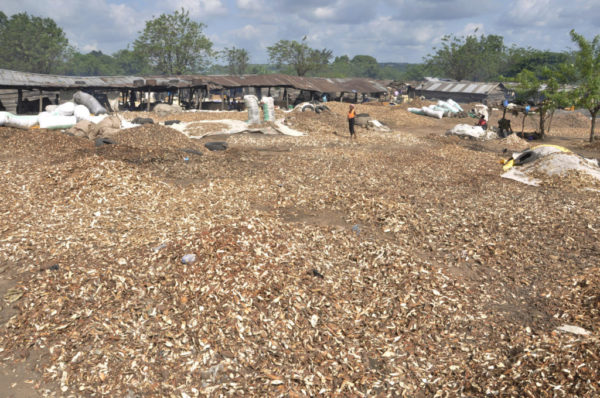To feed this growing industry, however, stress on staple crops like maize and corn is increasing, creating competition between grain for human food and animal feed. In response to this challenge, CGIAR scientists have developed a livestock feed supplement that is relieving the stress on these staple crops by using an abundant agricultural waste product – cassava peels.
From waste to wealth
Over the last five years, scientists from International Livestock Research Institute (ILRI), and the International Institute of Tropical Agriculture (IITA) with support from the CGIAR Research Program on Root Tubers and Bananas (RTB) have developed a processing method that transforms wet cassava peels into high quality, safe, and hygienic animal feed ingredients, known as High Quality Cassava Peel mash (HQCP). This new component of the cassava value chain has the potential to become a USD2 billion a year industry on the continent and employ 100,000 more people, 80% of whom it is estimated will be women.
Normal cassava production and processing produces waste; 50 million tonnes per year of peels, stumps, undersized, or damaged cassava are either burned or left to rot in piles, both of which pollute the air, soil, and groundwater.
“Cassava peel heaps have been shown to yield significant quantities of bioethanol. Scaling the transformation and use of cassava peel into animal feed ingredients instead of letting them rot in heaps will reduce greenhouse gas emissions,” says Iheanacho Okike of the International Institute of Tropical Agriculture (IITA) who leads the Cassava Peel Transformation project.
In recognition of the success of the technology and its potential to benefit the environment, economy, and livelihoods, RTB awarded the project a grant through the RTB Scaling Fund. The funding, in addition, to support from RTB’s Flagship Project 5 on ‘Improved livelihoods at scale’, has helped the project to identify bottlenecks and corresponding solutions to scale the technology.
What was once a nuisance and a greenhouse gas emitter has become a potential additional income source for three million cassava producers. Some systematic roadblocks have constrained the industry from growing to its full potential, like widespread geographic distribution, limited knowledge of feed nutrition, and communication.
As part of scaling efforts, which also include training and access to credit, three ICT solutions have been developed and deployed by the project to help overcome these challenges and grow the industry.
Connecting the dots
Investors and entrepreneurs are excited about the potential of this commodity growing in value, however, finding the right cassava peel products and processing plant has been a risky. “Investors can take advantage of the Cassava Peel Tracker to locate factories that are central and in close proximity to clusters of cassava processing centers” explains Okike.
IITA scientists developed the Cassava Seed Tracker® an app that facilitates the identification and tracking of cassava planting materials by varieties. In collaboration with the project, that app was modified to make identifying sources of cassava peels and cassava peel products a safer bet. The app can show users not only where cassava processing centers are, but also the volumes of fresh peels generated daily at each location. The Cassava Peel Tracker app was developed and launched in November 2018 and has already geo-referenced more than 25% of the 5000 cassava processing centers in Nigeria. This information improves overall efficiency and profitability by supporting decision making on the optimal facilities to work with based on location and production.
Creating Communities of Practice
Additionally, the project is supporting the quickly growing community of peel production entrepreneurs and investors. The Cassava Peel First Movers group, a WhatsApp-based Community of Practice, now has over 180 active members. Members exchange information on trainings, technical aspects of peel production, and discuss economic information such as the costs of raw materials and fluctuations in market prices
Calculating feed recipe rations – there’s an app for that too
“It is no surprise that HQCP is getting into both the livestock and fish feed industries. HQCP inclusion in compound feed can only grow!” exclaims Okike.
Animal feedmillers have been incorporating the high-quality cassava peel mash into their recipes for both livestock and fish feed faster than initially anticipated. By the end of 2018, almost 800 new recipes included a ration of cassava peel mash, and with the help of a new app called FeedCalculator®, there’s only room for more. The project has deployed another app designed to help feedmillers and farmers formulate least cost, nutritionally-balanced rations for animal feed that incorporate the HQCP.
Thanks to its high nutritional content, Okike says “HQCP is relieving the stranglehold of maize on the feed industry by producing [a] cheaper source of excellent quality energy.”
High potential for HQCP
This new private sector-driven industry conservatively valued at USD450 million was born from a waste product and is now benefitting cassava producers, processors, entrepreneurs and consumers – with the potential to create 100,000 new jobs. By looking critically at the value chain and embracing ICTs to connect different groups, improve communication, share knowledge, and provide advice, the project is moving towards its goals. It is hoped that the success of using cassava peels as quality livestock feed will inspire other crop industries in the agricultural sector to think differently about their byproducts and investigate alternative uses for waste.


